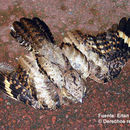zh-TW
在導航的名稱


The San Lucas nighthawk (Chordeiles acutipennis), also referred to as the lesser nighthawk3, averages 20 cm to 23 cm (7 to 9 inches) in length its wing span is about 53 cm (21 inches)4. It has a short bill; the upper parts of the body have a gray and white patterning. Its head and chest are brown, with white patterning, and the underside of the bird has dark bars that run across its stomach1. The wings are dark with pale patches on the bend, and the tail has thin white layers at the top. An adult male will have a white stripe at the throat, while the female will have spots on inner parts of the wings and throat.
The native range for the San Lucas nighthawk ranges along the southwestern United States from California to Texas. From the Mexico border to the San Joaquin valley the bird is scarce1. The breeding ground for the San Lucas nighthawk extends from Baja California and through Mexico all the way to Central America. They prefer open land with primarily arid habitats. The lesser nighthawk prefers large open areas. They like relatively level topography and naturally open land, as opposed to disturbed open lands with weeds1.
The San Lucas nighthawk’s diet consists primarily of invertebrates (insects) and are most active at night and dawn/dusk. In the morning they forage in the air often catching insects low to the ground, while at night they forage around bright city lights; they may also feed on the open ground at night2. It is therefore expected to have a positive effect on the environment as it can help keep the insect population under control.
Mostly nocturnal, they nest far from human disturbance typically in May or June which is later than most lowland species. Males will use a series of calls to attract females1. Breeding from early spring to mid-summer, females lay two speckled eggs. The nest is constructed at ground level, often placing the eggs on open soil. The mother will incubate the eggs for eighteen to twenty days. There they sit quietly nesting with minimal movement to avoid detection. The parent not incubating the eggs will be the one to roost away from the nesting area. Delivering one brood annually, nestlings are semi-precocial and downy, are tended by both adults, and can fly in about 3 weeks2. Once hatched they are fed regurgitated food by both parents. Once they are able to fly, the young nighthawks leave the nest.
The San Lucas nighthawk prefers to be in open land with low human disturbances1. Much of its natural habitat has been lost due to urbanization and expansion of cities into rural land, causing bird communities that include the San Lucas nighthawk to shift toward assemblages dominated by fewer, more abundant and more typical ‘urban’ species5. The San Lucas nighthawk is scarce but the conservations status is uncertain.